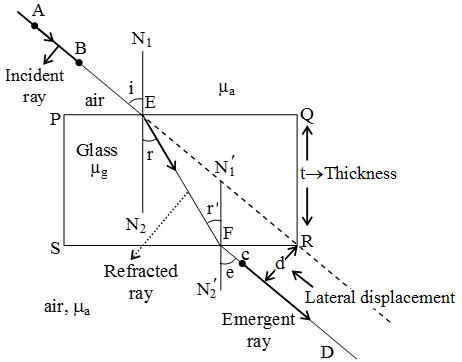NCERT Solutions for Class 10th Refraction of light through glass slab
Refraction Through a Glass Slab
Introduction
Refraction through a glass slab occurs when light passes from one medium to another and changes its direction twice: when entering and when leaving the slab. The glass slab is typically a rectangular block made of transparent material such as glass or plastic.
Explanation of Terms
- Incident Ray: The ray of light that strikes the surface of the glass slab.
- Refracted Ray: The ray that bends inside the glass slab after refraction.
- Emergent Ray: The ray that exits the glass slab after refraction at the second boundary.
- Angle of Incidence (i): The angle between the incident ray and the normal at the point of incidence.
- Angle of Refraction (r): The angle between the refracted ray and the normal at the point where light enters the glass slab.
- Angle of Emergence (e): The angle between the emergent ray and the normal at the point where light exits the glass slab.
- Normal: A line perpendicular to the surface of the glass slab at the point of incidence or emergence.
Experiment Setup
The experiment to observe the refraction through a glass slab involves the following setup:
- Place a rectangular glass slab on a sheet of paper and draw its outline.
- Draw a normal at the point where the incident ray strikes the glass slab.
- Shine a ray of light (incident ray) at an angle to the normal, and observe the refraction inside the glass slab.
- Mark the path of the refracted ray and emergent ray on the sheet.
 >
>Observations
During the experiment, the following observations can be made:
- The incident ray bends towards the normal when entering the glass slab, as light slows down in the denser medium (glass).
- The emergent ray bends away from the normal as it exits the glass slab and re-enters a rarer medium (air).
- The incident ray and the emergent ray are parallel to each other, but shifted by a lateral displacement.
Results
The experiment shows that the light ray bends twice—first when entering the glass slab and again when leaving it. The emergent ray is parallel to the incident ray but laterally displaced. This is due to the refraction that occurs at both boundaries of the glass slab.
FAQs on Refraction Through a Glass Slab
1. What is refraction through a glass slab?
Refraction through a glass slab occurs when a light ray passes through the slab, bending as it enters and exits due to the difference in refractive indices between air and glass.
2. Why does the emergent ray remain parallel to the incident ray?
The emergent ray remains parallel to the incident ray because after bending twice (once at each surface of the glass slab), the light ray returns to its original direction but gets shifted by a lateral displacement.
3. What causes the bending of light inside the glass slab?
The bending of light, or refraction, occurs due to the change in speed of light as it passes from air (rarer medium) into glass (denser medium) and vice versa.
4. What is lateral displacement?
Lateral displacement is the sideways shift of the emergent ray from its original path. The emergent ray is parallel to the incident ray but displaced due to the refraction inside the glass slab.
5. Does the angle of incidence equal the angle of emergence?
Yes, the angle of incidence is equal to the angle of emergence because the light ray refracts symmetrically when it enters and exits the glass slab.
6. Why does light bend when it enters a glass slab?
Light bends when entering a glass slab because it slows down in the denser medium (glass), causing it to change direction.
7. How is the refractive index related to refraction through a glass slab?
The refractive index is a measure of how much the light slows down in a medium. The greater the refractive index, the more the light ray bends when it passes through the medium.
8. Can we observe refraction with other materials besides glass?
Yes, refraction can occur with any transparent material such as water, plastic, or air. The extent of bending depends on the refractive index of the materials involved.
9. What is the significance of normal in refraction experiments?
The normal is an imaginary line perpendicular to the surface at the point of incidence. It is used to measure the angles of incidence, refraction, and emergence.
10. Why is the incident ray not the same as the emergent ray in a glass slab?
The incident and emergent rays are not the same because they are laterally displaced due to the refraction inside the glass slab. However, they remain parallel to each other.


